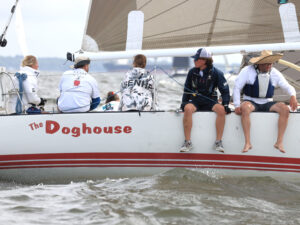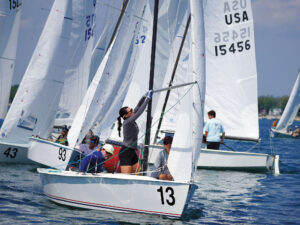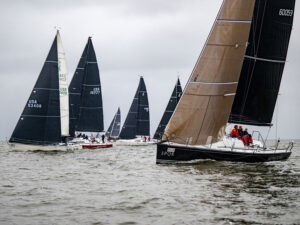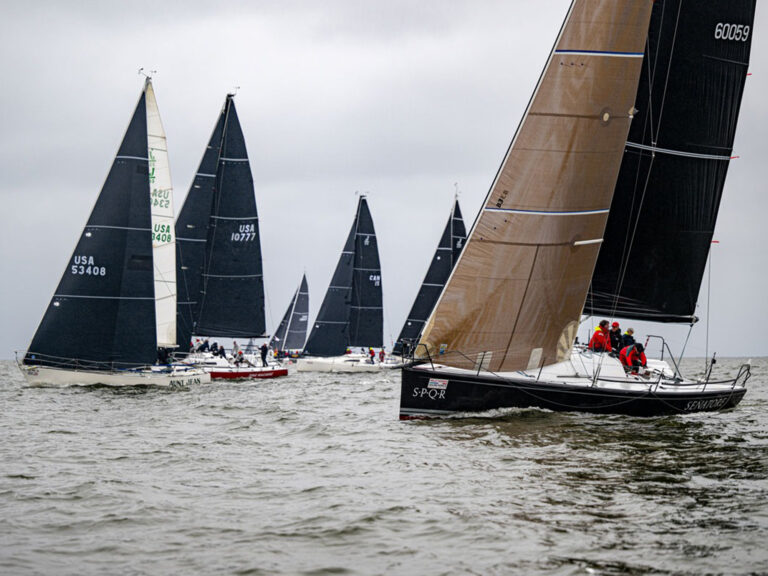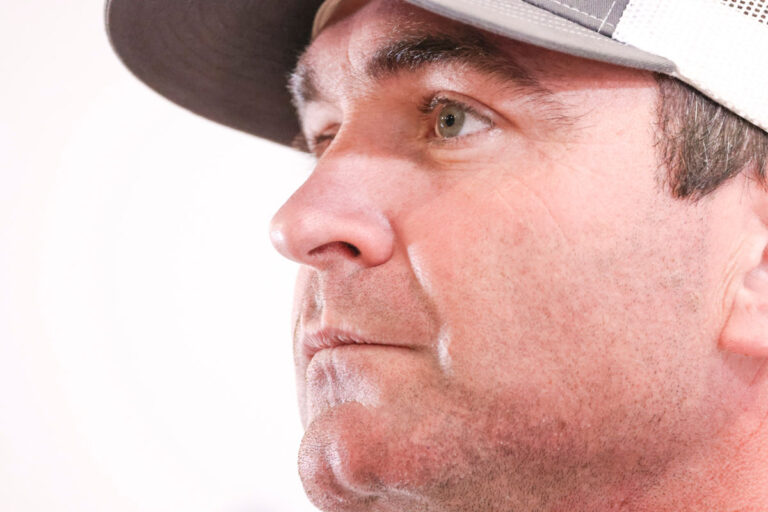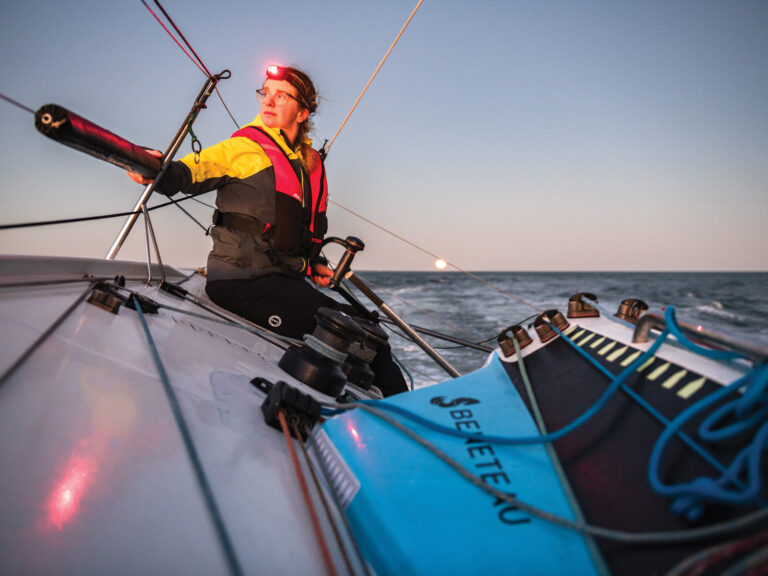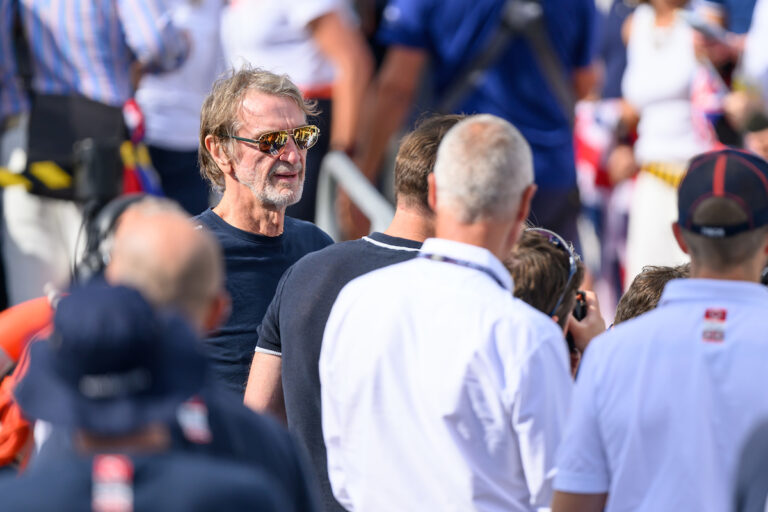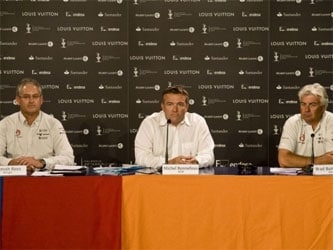
AC07_0705_Main
VALENCIA, Spain-Four years ago, when Alinghi won the right to organize the 32nd America’s Cup, we all knew the event was in for a big change. So I don’t think too many in the press corps was surprised to leave the protocol announcement at the team’s base on Halsey Street in early March 2003 with more questions than they carried into it.For today’s announcement of the protocol for the 33rd America’s Cup, there was the hope, however, that we’d leave the press conference with a good idea what to expect, and when. Many of us were anticipating that Alinghi would announce that the 33rd Cup would be held in Valencia in 2009 in the America’s Cup Class boats, albeit under Version 6.0 of the class rules. It seemed like the simplest and most effective way to build on the tremendous momentum created by the remarkable 32nd America’s Cup match, which Alinghi won 5-2 over Emirates Team New Zealand on Tuesday. However, that wasn’t what took place. Alinghi announced that the 33rd match-for which Desafio Español is the challenger of record-will be in a new class of boat and that Valencia is one of an unknown number of cities that will be considered to host the regatta. The competition could take place in 2009, but only if Valencia and America’s Cup Management can come to an agreement in the next few months, or in 2010 or 2011 if the venue changes. The protocol also enables the defender to sail in the early rounds of the challenger selection series.So I emerged from today’s meeting with much the same level of confusion I had four years ago. However, what I didn’t have was a sense of excitement about the future of the Cup, which was overwhelmingly present four years ago. It seemed bound for a better place then. Now, I’m not sure where it’s headed, in every sense of the word. This isn’t to say that I doubt Alinghi’s stewardship of the Cup. While I haven’t agreed with everything they’ve done this time around, the end result was a fantastic event. The Acts were a huge success and the venue is fantastic. Alinghi deserves credit for moving the Cup forward, for elevating it in the world of sports. It’s just that I don’t know what to think this time around.I think the biggest difference is that the 31st America’s Cup was a disappointment across the board. The entire contest was marred by nearly constant courtroom wrangling over arcane rules, the final was a 5-0 blowout, the Louis Vuitton final was only marginally closer, and inclement weather forced the Cup match to stall for a week, killing whatever remaining spectator interest existed at that point. Everyone could see that change was needed.At the moment, however, we’re coming out a fabulous match, which capped off a fabulous regatta. Certainly it wasn’t perfect, but compared to the previous three it was a huge improvement. So the biggest question in my mind, looming well above what boats will they sail and where, is if it ain’t broke, why take such drastic steps to fix it?First, though, let’s get to the details, what few there are. The new class will be 90 feet in length, and Alinghi skipper Brad Butterworth stressed that the boats will be much faster, which probably means they’ll be much lighter as well. The draft will be 21 feet, but a mandatory sliding-keel system will be used to reduce draft to 13 feet to facilitate getting into and out of shallower ports like Valencia. Butterworth said that unlike the ACC rule, this one won’t be created by a committee of designers as he doesn’t feel that’s very effective. He said that Grant Simmer, Alinghi’s design coordinator, and Rolf Vrolijk, the team’s head designer, would likely be involved.Canting keels are not likely to be part of the package. Hydraulic or electric winches are definitely not going to be allowed. The boat will require a few more crew, maybe 20 or 21. Butterworth said that teams might be limited to just one new boat for this coming Cup cycle. Eliminating two-boat testing from the process would represent a substantial savings to each team. The hull will have to be laminated in the country of origin for each challenge. But that is the only nationality-based rule in the protocol. Designers will be locked into a team 30 days after the rule is announced, which will happen before the end of 2007, and sailors will be locked into a team as of Oct. 1, 2008.Because of the one-new-boat rule, Alinghi may be allowed to participate in the challenger selection series until the final of that series. This was a bone of contention at a press conference held at Desafio Español. Basically the Spanish team spent much of the press conference, which was held in Spanish, defending itself; many in the press felt they didn’t show enough backbone in drafting the protocol. They said they did what they could, but the challenger of record is in a weak position and they had few options. Among the things they fought for was an 18-month gap between when the new rule is decided and when the America’s Cup regatta is sailed, feeling that was near the minimum required to build, test, and ready a 90-foot yacht.The Challenger Commission has been abolished, though Areva Challenge’s Stephan Kandler didn’t seem too upset about that, noting that they Challenger Commission had little power and what power it did have was drastically reduced by the fact that they challengers rarely agreed on anything. The other change was to reconstitute an arbitration panel to handle all business-related disputes. A sailing jury, a new creation, will handle anything related to the competition. Both the arbitration panel and the jury will be comprised of three members.There are other bits and piece in the protocol. But that’s the big picture. It’s a lot to take in. Personally, I’m of two minds when I look at this, one rather cynical, the other a bit more dewy-eyed and optimistic. I’ll start with the latter.Dewy-eyed Stu’s Thoughts The class is archaic and needs to be changed. Bigger faster boats will excite the public. Faster boats will also make for more exciting racing, more passing, in other words, better TV coverage. Introducing a new class, and restricting each team to one new boat, is necessary to eliminate two-boat testing, which in turn eliminates the need for two full race crews and reduces each team’s overall budget. Now I’m not sure the professional sailors union will like that-wait your turn, Cynical Stu-but if the boats are bigger and require more crews, limited the number of sailors each team employs is probably essential to draw in smaller teams who might otherwise be quickly priced out. Eliminating the two-boat testing program actually hurts Alinghi more than other teams as the Swiss team has shown a remarkable ability to refine its boats over a period of time in the past two America’s Cup contests. The Challenger Commission was ineffective and streamlining the decision-making process will benefit the sport. The rules will be the rules, everyone is better off if they’re written quickly by a smaller group. Then all the teams can get to the business of trying to figure out how to work around them-down boy, down! The elimination of two-boat testing will put an increased importance on the pre-regattas, making these events more interesting to the general public and much more sellable to sponsors. It will also place more emphasis on the pro Match Racing Circuit, which is a great grass-roots way to build interest in the sport and bring match racing to places and sailors who are not that familiar with it.Cynical Stu’s Thoughts Emirates Team New Zealand gave Alinghi a fright in the 32nd America’s Cup. The best way for the team to keep its edge is to create a new class-by itself, giving it a nice headstart on the design-and play to its strengths, research and design. The chance of the top two teams in the 33rd Cup Match being as close in speed as NZL-92 and SUI-100 is slim to none. In the early days of a new rule, the speed differences between the teams will be much higher; the racing won’t be very close. The public doesn’t care how fast sailboats go: 12 knots, 15 knots, 20 knots. It’s still a slow-motion sport. Close racing is what excites people. The Cup should work on that. There’s a limited value to marginal increases in overall speed. Allowing the defender to sail in part of the challenger elimination series is rife with problems, especially if it doesn’t count in the end. It’s like inserting exhibition games in the middle of the baseball season. Why would a challenger push hard against Alinghi, and potentially break something, when there’s nothing to gain. Plus it takes away one unique element of the America’s Cup, though this was already compromised by the Acts. How are teams supposed to refine their skills and boatspeed if they can’t two-boat test? Will the sailing be at the same level as it was this time?As I said, I’m having a hard time coming to grips with these changes. Maybe that’s something of a natural reaction. I just can’t shake the feeling that the people in positions of power think sailing has a lot more capital, in terms of public perception, to work with. That said, Alinghi did a good job with the 32nd and there’s no reason to think they won’t with the 33rd. Let’s just hope ACM and Valencia can some to an agreement in short order and the design team can get the new rule formulated in a hurry. Once again, Alinghi seems determined to lead the Cup in a new direction. I kind of liked the old direction, the one it picked four years ago, but it’s not my choice is it. As Alinghi president Ernesto Bertarelli said a couple of weeks ago, if you want to influence the direction of the Cup, first you’ve got to win it. He’s won it, twice now, and that means we live by his rules. God speed, Ernesto.

